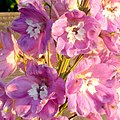| Garden delphiniums | |
|---|---|
 | |
| Scientific classification | |
| Kingdom: | Plantae |
| Clade: | Tracheophytes |
| Clade: | Angiosperms |
| Clade: | Eudicots |
| Order: | Ranunculales |
| Family: | Ranunculaceae |
| Genus: | Delphinium |
| Species: | D. ×cultorum |
| Binomial name | |
| Delphinium ×cultorum Voss | |
Garden delphiniums are horticultural hybrids derived from some perennial species in the genus Delphinium . Breeding of garden delphiniums started from the 19th century in Western Europe. In the 20th century, the United States, Japan and New Zealand also contributed to delphinium breeding.














